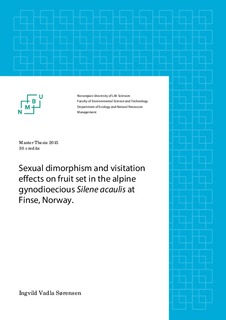| dc.description.abstract | The abundance of pollinators in alpine areas are scarce due to harsh and unstable weather conditions. This scarcity can lead to pollen limitation in unisexual plants and drive evolution towards self-compatible plants. Unisexual plants may have an advantage in favourable years if self-pollinating plants experience inbreeding depressions. Different dependence on pollinator visitation for different sexual morphs of a species can lead to sexual dimorphism in pollinator attracting traits, such as flower size. I did field studies and statistical analyses to investigate the predictions: I) Hermaphrodites will have larger flowers than females, II) visitation frequency will be higher on plants with large flowers and higher flower density, III) female flowers will have higher fruit production, and IV) pollen limitation is stronger in females than in hermaphrodites.
The field studies were done at Finse on Hardangervidda in Norway with three populations of Silene acaulis along an environmental gradient from 1300 to 1450 m.a.s.l. during June to August 2014. To study effects of plant and flower size, abundance of plants and sex on flower visitations and fruit production, 20 pairs consisting of one female and one hermaphrodite plant were observed. To quantify pollen limitation I preformed a supplemental pollination experiment on 5-6 pairs in each of the three populations.
Hermaphrodites had 25.9 % larger flowers than females, and a higher pollinator visitation frequency. Visitation frequency was also higher in populations with high plant abundance and increased with flower size. Females had 4.2 times higher fruit set than hermaphrodites. Results from the supplemental pollination experiment show that hermaphrodites have a stronger pollen limitation, and increased significantly their mean seed production by 124 % after supplemental pollination, while females did not significantly increase their seed production after supplemental pollination.
These results show that there is a sexual dimorphism in Silene acaulis at Finse. I suggest that the difference in flower size and fruit set is because hermaphrodites are functionally males in this population, and have a higher reproductive output, by pollen dispersal, from increased pollinator visitation, and therefore have larger flowers than females. This gynodioecious population may be evolving towards dioecy, but it is also possible that seed production is higher in hermaphrodites, relative to females, in less favourable seasons than the summer of 2014. | nb_NO |
